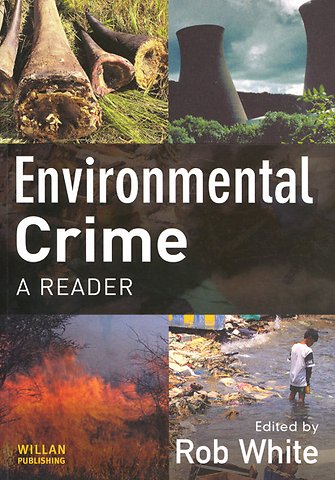Environmental crime
A Reader
Ingenaaid Engels 2009 9781843925125Samenvatting
Milieustrafrecht is een onderwerp dat zich in een groeiende belangstelling mag verheugen. Dit boek geeft een algemene introductie in dit onderwerp door essentiële artikelen en bronnenmateriaal op dit opkomende rechtsgebied.
Het bespreekt dit rechtsgebied in de breedste zin van het woord. De artikelen gaan over vervuiling, illegale stortingen en illegaal hout. Ook de vervolging van dit soort activiteiten en de preventie worden in dit boek behandeld.
Het boek is geschikt voor studenten, onderzoekers, beleidsmakers, politie, rechters en verder iedereen die geïnteresseerd is in milieuzaken.
Specificaties
Lezersrecensies
Inhoudsopgave
(Rob White)
Studying environmental crime: key words, acronyms and sources of information
(Diane Heckenburg)
PART ONE: CONCEPTUALISING ENVIRONMENTAL CRIME
Introduction
1 Crime, ecophilosophy and environmental harm
(Mark Halsey and Rob White)
2 Criminological semantics: conservation criminology – vision or vagary?
(F.J.W. Herbig and S.J. Joubert)
3 Environmental issues and the criminological imagination
(Rob White)
4 The meaning of green: contrasting criminological perspectives
(Michael J. Lynch and Paul B. Stretesky)
5 Corporate environmental crimes and social inequality: new directions for environmental justice research
(David R. Simon)
6 Logging and legality: environmental crime, civil society, and the state
(Penny Green, Tony Ward and Kirsten McConnachie)
7 The World Bank and crimes of globalization: a case study
(David O. Friedrichs and Jessica Friedrichs)
8 Rights and justice on a shared planet: more rights or new relations?
(Ted Benton)
9 For a nonspeciesist criminology: animal abuse as an object of study
(Piers Beirne)
10 An environmental victimology
(Christopher Williams)
11 Reflections on environmental justice: children as victims and actors
(Sharon Stephens)
12 Against 'green' criminology
(Mark Halsey)
PART TWO: DYNAMICS OF ENVIRONMENTAL CRIME
Introduction
13 Environmental crimes: profiting at the earth's expense
(Charles W. Schmidt)
14 Environmental crime in global context: exploring the theoretical and empirical complexities
(Rob White)
15 Environmental crime and pollution: wasteful reflections
(Alan A. Block)
16 Historical context and hazardous waste facility siting: understanding temporal patterns in Michigan
(Robin Saha and Paul Mohai)
17 Resisting toxic militarism: Vieques versus the U.S. Navy
(Déborah Berman Santana)
18 The politics of illegal dumping: an environmental justice framework
(David N. Pellow)
19 The impact of race on environmental quality: an empirical and theoretical discussion
(Raquel Pinderhughes)
20 Environmental genocide: Native Americans and toxic waste
(Daniel Brook)
21 The illegal market in Australian abalone
(Rebecca Tailby and Frances Gant)
22 Lobster poaching and the ironies of law enforcement
(John L. McMullan and David C. Perrier)
23 Crime, bio-agriculture and the exploitation of hunger
(Reece Walters)
24 Toxic crimes: examining corporate victimization of the general public employing medical and epidemiological evidence
(Michael J. Lynch and Paul Stretesky)
PART THREE: ENVIRONMENTAL LAW ENFORCEMENT
Introduction
25 Combatting international environmental crime
(Duncan Brack)
26 Transnational environmental crime in the Asia Pacific: an 'un(der) securitized' security problem
(Lorraine Elliott)
27 Police, law enforcement and the environment
(Kevin Tomkins)
28 Strengthening the weakest links: strategies for improving the enforcement of environmental laws globally
(Anita Sundari Akella and James B. Cannon)
29 When the heavenly gaze criminalises: satellite surveillance, land clearance regulation and the human-nature relationship
(Robyn Luise Bartel)
30 Reducing the illicit trade in endangered wildlife: the market reduction approach
(Jacqueline L. Schneider)
31 Corporate self-policing and the environment
(Paul B. Stretesky)
32 Can criminal law protect the environment?
(Helena Du Rées)
33 Excuses, excuses: the ritual trivialisation of environmental prosecution
(Paula de Prez)
34 Environmental crime and the courts
(House of Commons, Environmental Audit Committee)
35 Thinking outside the 'black box': tailored enforcement in environmental criminal law
(David C. Fortney)
36 Reducing vulnerabilities to crime of the European waste management industry: the research base and the prospects for policy
(Nicholas Dorn, Stijn Van Daele and Tom Vander Beken)
Index
Vaak samen gekocht
Anderen die dit boek kochten, kochten ook
Rubrieken
- advisering
- algemeen management
- coaching en trainen
- communicatie en media
- economie
- financieel management
- inkoop en logistiek
- internet en social media
- it-management / ict
- juridisch
- leiderschap
- marketing
- mens en maatschappij
- non-profit
- ondernemen
- organisatiekunde
- personal finance
- personeelsmanagement
- persoonlijke effectiviteit
- projectmanagement
- psychologie
- reclame en verkoop
- strategisch management
- verandermanagement
- werk en loopbaan









